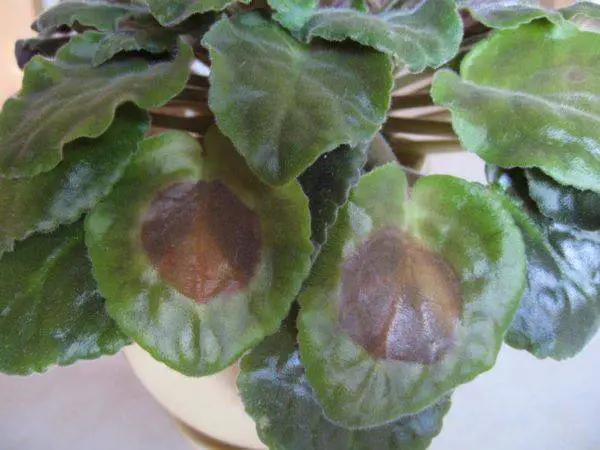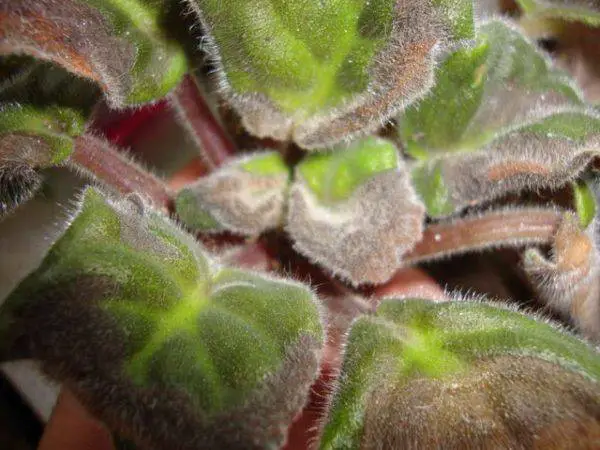As with other indoor plants, brown spots sometimes form African violet leaves turning brown with spots.
Their appearance can be caused by various reasons, but a correct diagnosis will allow you to restore the health and appearance of the flower in a short time.

why African violet leaves turning brown with spots?
There are various reasons why brown spots appear on the leaves.
For various reasons, brown spots may appear on the leaves of the violet.
Their early identification will help maintain the health of your beloved flower.
Causes of leaves brown spots
Why do brown spots appear on violet leaves? The appearance of brown spots on violet leaves can be associated with :
- As with impaired care;
- So is the disease of the flower.
Improper care
Not many people know why the leaves turn brown. At the first signs of detection of spots, the conditions of the plant should be analyzed:
- With prolonged exposure to direct sunlight in the summer, burns appear on the leaves, which eventually turn brown. The burnt leaves are removed, and the flower is transferred to another place or the window is shaded;
- The edge of the leaf often turns brown at the beginning of the heating season due to a significant decrease in air humidity . In such a plant, the lower leaves are removed and the watering regime is normalized;
- The appearance of stains is provoked by watering with cold water. To avoid this, the water for irrigation should be at room temperature;
- Irregular yellow or silver-brown spots often appear under the influence of a draft during ventilation in the winter or a sharp drop in room temperature below 16 ℃. The same effect is caused by the contact of the sheet with a cold window in winter;
- Often brown spots on the lower leaves indicate alkalization of the soil . In an alkaline environment, some nutrients are poorly soluble in water and cannot be absorbed by the roots. Such a plant needs a transplant and a complete replacement of the soil.
Important! Depending on the cause of the appearance of spots on the leaves, the flower is transplanted into a new substrate or the conditions for its maintenance are adjusted.
Light plays important role in the life of plants so check out African Violet Light Requirements.
Fungal diseases
The appearance of brown spots on violet leaves is often the result of microbial infection. Therefore, the leaves were covered with brown spots.
Attention! Excessive watering of violets against the background of low cultivation temperatures and high humidity are ideal conditions for the development of fungal and bacterial diseases.
Fusarium wilt
Fusarium is a root disease in violets.
The fungal disease, which manifests itself in wilting, drilling, and subsequent death of leaves, darkening of the roots. Treatment is usually ineffective and the violet will die.
Gray rot
Why did the leaves turn brown? The mycelium of the fungus grows in the area of the outlet, then spreads up the plant:
- The stem and leaves are covered with small brown spots;
- The tips of the leaf blade turn brown;
- The flowers and buds are covered with mold.
Areas affected by gray rot die off.
Brown rot
The fungus affects:
- Stem;
- And leaves.
They acquire a brownish-brown color, over time, the tissues soften and die off . On the ground under the outlet, whitish filaments of mycelium are visible.
Phytophthora
Fungal disease of violets, practically not amenable to treatment:
- The first stage of the disease looks like a lack of water for the plant, but after watering the flower does not recover and withers even more;
- Then the disease spreads to the roots and root collar, stem and leaves.Late blight in violets is difficult to cure.
Important! Affected tissues turn brown and die off.
Bacterial lesions
Bacterial spots differ from those of fungal origin by the absence of spore-bearing pustules.
Bacterial burn
Why did brown spots appear on the leaves – what is it? It could be a fire blight. Bacteria of the genus Pseudomonas cause disease :
- In this case, the edge of the leaf looks as if burnt, over time, the disease covers the entire plant;
- The blackening area is shapeless.
This allows you to distinguish fire blight from bacterial blight.
Bacterial spot
What caused rust on the leaves: cause and treatment? In the initial phase, the disease manifests itself as small watery spots, which gradually change color, becoming brown and black.
They are often surrounded by a yellow or light green border. As the spots grow, the plant weakens and dies.
Detail guide on African Violet Leaves Turning Yellow.
Pests
Insect pests are a great danger to violets. Insects can appear not only on leaves but also on flowers.
Cyclamen mite
The growth point of the violet is striking, in his presence the flowers become smaller, the leaves :
- Are deformed;
- And they fall.
Spider mite
Small brown spots appear on the foliage as if the surface of the leaf was punctured by a needle.
Nematode
Dwells on the roots, feeding on the sap of the plant:
- In the initial phase of the disease, the pest is not detected;
- In the future, the leaves are covered with light green spots, which is why brown spots and decay appear as a result ;
- You can make a diagnosis by examining the root system when transplanting a flower.
Important! It is impossible to get rid of nematodes, so the infected flower is destroyed.
See also How to Get African Violet To Bloom Again.
Treatment methods for African violet leaves turning brown with spots

After improper care
The reason for rusty spots is different, therefore, having learned why this happened, the violet must be treated. A set of measures is carried out depending on the cause of wilting :
- In the case of alkalization of the soil, the plant is transplanted. The root is shaken off the ground and washed with a solution of potassium permanganate, then the violet is planted in new soil;
- Watering is carried out with warm water under the root of the flower, trying not to get on the leaves;
- If the plant has been overdried for a long time, watering is resumed in small portions once every few days.
Timely assistance provided will allow the plant to quickly recover.
Fungal diseases and infections
Brown edges of the leaves indicate that the violet is sick. The source of microbial infection can be :
- Another diseased plant;
- Soil infected with a pathogenic microbe;
- Infected instrument used when transplanting a flower.
First of all, a plant that is weakened as a result of improper care is exposed to the disease.
Treatment of diseased violets is carried out in a complex way:
- Chemical means of protection are used;
- Normalize care;
- Rejuvenate the flower.
Sometimes, in order to save the collection, you have to resort to drastic measures to the destruction of damaged plants. You can see how the brown spots appeared in the photo above.
To prevent the spread of infection, the infected violet is isolated and disinfected:
- Diseased leaves are removed and destroyed;
- In the case of a fungal infection, the plant is sprayed with a solution of the fungicide Fundazol, Bordeaux liquid, Skor or others;
- With a bacterial infection, the antibiotic Fitolavin, Streptomycin will help.
Important! In the case of diagnosing root rot, in order to preserve the variety, it is worth rooting a violet leaf.
After being hit by pests
When pests are found:
- Mechanically clean the surface of leaves and stems from insects;
- The flower is treated with an insecticide (Fitoverm, Actellik or others);
- After processing, a transparent bag is put on over the flower for a day.
To ensure that the pests get rid of the pests, repeat the treatment of violets after two weeks.
See also African Violet Leaf Diseases.
Prevention measures for African violet leaves turning brown
The creation of comfortable conditions of detention is the best prevention of diseases.
Important! To strengthen the immune system, stimulate the growth and flowering of violets, you can use natural biostimulants:
- Agate;
- Epinephrine;
- Potassium humate;
- Zircon;
- Succinic acid, etc.
These and other drugs are widely used in indoor floriculture. Not all growers know why violet leaves rust.
Taking proper care of the violet will ensure good growth and flowering.
To prevent the appearance of infectious diseases, plants after purchase must go through a two-week quarantine, after which it is put on a permanent place:
- Violet does not like bright sun, preferring northern and northeastern windows;
- The optimum cultivation temperature is + 20-25 ℃;
- Watering is carried out only after complete drying of the upper layer of the substrate;
- For feeding, fertilizers are used , developed specifically for violets or universal, the concentration of which is halved;
- Violets don’t like big pots. The diameter of the container should be three times less than the diameter of the leaf outlet. If in the process of transshipment the volume of the pot reached 9×9 cm (diameter x height), then in the future, the transplant is carried out into the same pot, shaking off the lower part of the soil and filling the ground from above.
Conclusion
Compliance with all standards for the care and maintenance of a flower is the basis for growing a healthy plant. You can prevent African violet leaves turning brown with proper care and maintenance.
